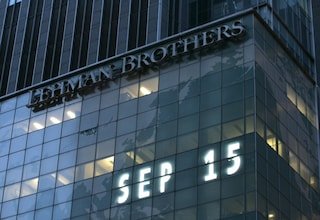
With the 10th anniversary of Lehman Brothers' collapse arriving Saturday, policymakers and industry insiders are reviving the debate over the regulation -- or the lack thereof -- of Wall Street. And over what could bring about the next financial crisis.
Here’s one bracing fact to keep in mind: Since the 2008 financial crisis, 30 percent of the lawmakers and 40 percent of the top staffers involved in forging the congressional response to the meltdown have gone to work for the industry. The figures, unearthed by my colleague Jeff Stein, point to the coziness between the regulators and the regulated. It's evident in a Washington debate now centered not over whether to tighten the screws applied since the crisis — but in how far to go in loosening them.
The details, from Jeff’s story:
The Post analysis found that Wall Street, K Street and firms representing financial interests have hired at least 15 of the 47 lawmakers who left Congress after serving on the House Financial Services Committee and Senate Banking Committee in August 2008, just before the financial crisis entered its most intense chapter. That number includes six of the 10 senators to leave Congress after serving on the Banking Committee. Seventeen of the 40 most senior staffers who served on the House Financial Services Committee in August 2008, as well as 15 of the 40 senior staff who served on the Senate Banking Committee at that time, later joined or took jobs representing a large financial institution.
Just as significant, but unreflected in those numbers, are the Obama-era executive branch officials who have similarly gone on to jobs in the industry. As Jeff notes, that roster includes former Treasury secretary Tim Geithner (now at private equity firm Warburg Pincus), his successor, Jack Lew (at private equity firm Lindsay Goldberg), and former Securities and Exchange Commission chair Mary Schapiro (who serves on the board of Morgan Stanley).
Source :With the 10th anniversary of Lehman Brothers' collapse arriving Saturday, policymakers and industry insiders are reviving the debate over the regulation -- or the lack thereof -- of Wall Street. And over what could bring about the next financial crisis.
Here’s one bracing fact to keep in mind: Since the 2008 financial crisis, 30 percent of the lawmakers and 40 percent of the top staffers involved in forging the congressional response to the meltdown have gone to work for the industry. The figures, unearthed by my colleague Jeff Stein, point to the coziness between the regulators and the regulated. It's evident in a Washington debate now centered not over whether to tighten the screws applied since the crisis — but in how far to go in loosening them.
The details, from Jeff’s story:
The Post analysis found that Wall Street, K Street and firms representing financial interests have hired at least 15 of the 47 lawmakers who left Congress after serving on the House Financial Services Committee and Senate Banking Committee in August 2008, just before the financial crisis entered its most intense chapter. That number includes six of the 10 senators to leave Congress after serving on the Banking Committee. Seventeen of the 40 most senior staffers who served on the House Financial Services Committee in August 2008, as well as 15 of the 40 senior staff who served on the Senate Banking Committee at that time, later joined or took jobs representing a large financial institution.
Just as significant, but unreflected in those numbers, are the Obama-era executive branch officials who have similarly gone on to jobs in the industry. As Jeff notes, that roster includes former Treasury secretary Tim Geithner (now at private equity firm Warburg Pincus), his successor, Jack Lew (at private equity firm Lindsay Goldberg), and former Securities and Exchange Commission chair Mary Schapiro (who serves on the board of Morgan Stanley).
Source: With the 10th anniversary of Lehman Brothers' collapse arriving Saturday, policymakers and industry insiders are reviving the debate over the regulation -- or the lack thereof -- of Wall Street. And over what could bring about the next financial crisis.
Here’s one bracing fact to keep in mind: Since the 2008 financial crisis, 30 percent of the lawmakers and 40 percent of the top staffers involved in forging the congressional response to the meltdown have gone to work for the industry. The figures, unearthed by my colleague Jeff Stein, point to the coziness between the regulators and the regulated. It's evident in a Washington debate now centered not over whether to tighten the screws applied since the crisis — but in how far to go in loosening them.
The details, from Jeff’s story:
The Post analysis found that Wall Street, K Street and firms representing financial interests have hired at least 15 of the 47 lawmakers who left Congress after serving on the House Financial Services Committee and Senate Banking Committee in August 2008, just before the financial crisis entered its most intense chapter. That number includes six of the 10 senators to leave Congress after serving on the Banking Committee. Seventeen of the 40 most senior staffers who served on the House Financial Services Committee in August 2008, as well as 15 of the 40 senior staff who served on the Senate Banking Committee at that time, later joined or took jobs representing a large financial institution.
Just as significant, but unreflected in those numbers, are the Obama-era executive branch officials who have similarly gone on to jobs in the industry. As Jeff notes, that roster includes former Treasury secretary Tim Geithner (now at private equity firm Warburg Pincus), his successor, Jack Lew (at private equity firm Lindsay Goldberg), and former Securities and Exchange Commission chair Mary Schapiro (who serves on the board of Morgan Stanley).
Source :https://wapo.st/2QjM9Uz
Hi! I am a robot. I just upvoted you! I found similar content that readers might be interested in:
https://www.washingtonpost.com/business/economy/many-lawmakers-and-aids-who-crafted-financial-regulations-after-the-2008-crisis-now-work-for-wall-street/2018/09/07/50f63a1e-b075-11e8-a20b-5f4f84429666_story.html